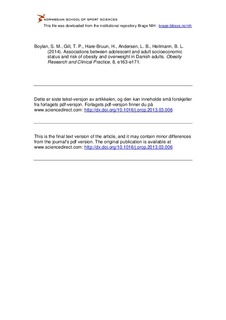| dc.contributor.author | Boylan, Sinead M. | |
| dc.contributor.author | Gill, Timothy P. | |
| dc.contributor.author | Hare-Bruun, Helle | |
| dc.contributor.author | Andersen, Lars Bo | |
| dc.contributor.author | Heitmann, Berit L. | |
| dc.date.accessioned | 2015-05-22T11:59:12Z | |
| dc.date.available | 2015-05-22T11:59:12Z | |
| dc.date.issued | 2014-04 | |
| dc.identifier.citation | Obesity Research and Clinical Practice. 2014, 8, e163-e171 | nb_NO |
| dc.identifier.uri | http://hdl.handle.net/11250/283968 | |
| dc.description | I Brage finner du siste tekst-versjon av artikkelen, og den kan inneholde ubetydelige forskjeller fra forlagets pdf-versjon. Forlagets pdf-versjon finner du påwww.sciencedirect.com: http://dx.doi.org/10.1016/j.orcp.2013.03.006 / In Brage you'll find the final text version of the article, and it may contain insignificant differences from the journal's pdf version. The original publication is available at www.sciencedirect.com: http://dx.doi.org/10.1016/j.orcp.2013.03.006 | nb_NO |
| dc.description.abstract | It has been suggested that socioeconomic status (SES) may influence the risk of obesity; however it is important to consider individual changes in SES over the life-course in addition to SES at specific time-points to better understand the complex associations with obesity. We explored the relationship between lifetime-specific and life-course SES and risk of obesity and overweight in Danish adults.
Methods: Data were used from the Danish Youth and Sports Study (DYSS) – a 20–22 year follow-up study of Danish teenagers born between 1964 and 1969. Baseline data gathered in 1983 and 1985 included self-reported BMI, SES and physical activity. The follow-up survey (2005) repeated these assessments in addition to an assessment of diet. Complete data on adolescent and adult SES and BMI were available for 623 participants.
Results: Following adjustments, adolescent SES had no significant association with overweight/obesity in this sample, however females of low or medium adult SES were significantly more likely to be overweight/obese compared to those of high SES (low SES: OR: 2.7; 95% CI: (1.3–5.8); p = 0.008; medium SES: OR: 4.0, 95% CI (1.6–10.2); p = 0.003). Females who decreased in SES during adulthood were significantly more likely to be overweight/obese compared to those who remained of high SES (OR: 3.1; 95% CI (1.1–9.2); p = 0.04).
Conclusion: Effects of early life-factors may be conditional upon the environment in adulthood, particularly for the women. Further research should consider the timing of SES exposure and the mechanisms which may be responsible for the socioeconomic gradients in prevalence of obesity and overweight. | nb_NO |
| dc.language.iso | eng | nb_NO |
| dc.publisher | Elsevier | nb_NO |
| dc.subject | obesity | nb_NO |
| dc.subject | overweight | nb_NO |
| dc.subject | socioeconomic | nb_NO |
| dc.title | Associations between adolescent and adult socioeconomic status and risk of obesity and overweight in Danish adults | nb_NO |
| dc.type | Journal article | nb_NO |
| dc.type | Peer reviewed | nb_NO |
| dc.subject.nsi | VDP::Medical disciplines: 700 | nb_NO |
| dc.source.journal | Obesity Research and Clinical Practice | nb_NO |
| dc.description.localcode | Seksjon for idretssmedisinske fag / Department of Sports Medicine | nb_NO |
